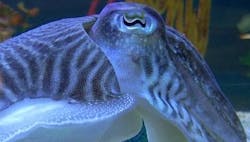Modified LCD helps measure sensitivity of cuttlefish polarization vision
Bristol, England--Using a liquid-crystal display (LCD) screen modified to vary polarization angle instead of intensity, researchers at the University of Bristol discovered that cuttlefish have the most acute polarization vision yet found in any animal.1
For the experiment, an LCD computer screen's outer (front) polarizing filter was removed; as a result, the optical output of the liquid-crystal layer shows as its true polarization-angle variations rather than as grayscale variations. The LCD pixels can independently display polarization e-vector orientations of 0° to 90° while maintaining high-quality linear polarization of greater than 96%. Images and videos shown on the LCD are therefore visible only to animals with polarization-sensitive vision.
Cuttlefish and their colorblind cousins, squid and octopus, see aspects of light, including polarized light, that are invisible to humans. "Just like color and intensity, polarization is an aspect of light that can provide animals with information about the world around them," said lead researcher Shelby Temple.
Polarization-sensitive to 1°
With collaborators at The University of Queensland (Brisbane, Australia), the team gave cuttlefish an eye exam by measuring the smallest difference in the angle of polarization the cuttlefish could detect. The researchers took advantage of the chameleon-like color changes that cuttlefish use for camouflage as a way of measuring whether the animals could detect the polarized stimuli.
They played videos of approaching objects and watched for changes in skin color patterns to determine if the cuttlefish could see small changes in polarization contrast, explained Temple. "Cuttlefish change color all the time and respond to the slightest movement so they are an excellent model," he added. The videos depicted large, looming objects to evoke escape responses, and small, prey-like objects to stimulate pursuit.
"Cuttlefish were much more sensitive than we expected. It was previously thought that polarization sensitivity was limited to about 10° to 20° differences, but we found that cuttlefish could respond to differences as small as 1°."
In addition to measuring the limits of polarization vision in the cuttlefish, the team also modeled how underwater scenes might look to an animal that has such high-resolution polarization vision. Using colors instead of changes in polarization angle they created images of the polarized world that humans can see and showed that there is much more information available in the polarization dimension than was previously known.
"These extraordinary findings suggest that we need to reexamine how we have been measuring the visual world underwater," said coauthor Justin Marshall of The University of Queensland. "Cuttlefish may be using the polarization of light much like we use color, which means we may need to look at camouflage and communication underwater in a whole new way."
REFERENCE:
1. S. E. Temple et al., Current Biology, Vol. 22, Issue 4, p. R121, 21 February 2012.

John Wallace | Senior Technical Editor (1998-2022)
John Wallace was with Laser Focus World for nearly 25 years, retiring in late June 2022. He obtained a bachelor's degree in mechanical engineering and physics at Rutgers University and a master's in optical engineering at the University of Rochester. Before becoming an editor, John worked as an engineer at RCA, Exxon, Eastman Kodak, and GCA Corporation.
